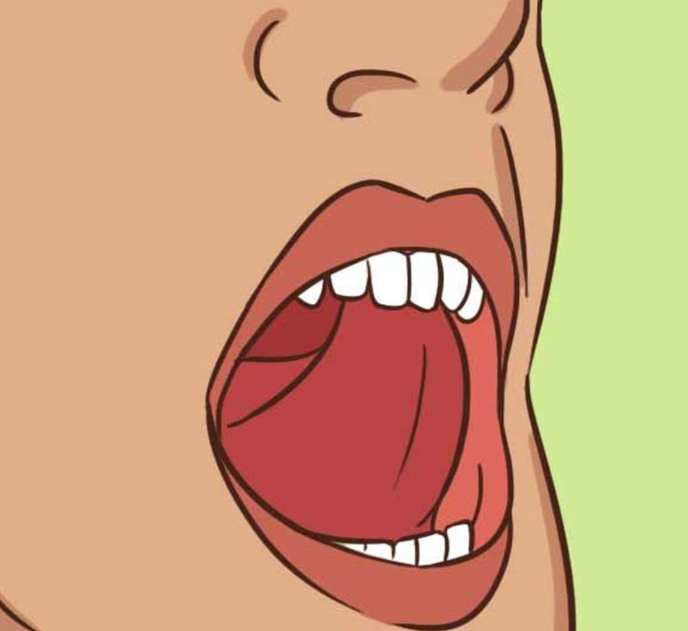In the pursuit of better health, clarity of mind, and stress relief, we often overlook the simplest techniques. One such technique is touching your tongue to the roof of your mouth while breathing. Though this adjustment may seem small, the effects can be transformative, benefiting both your body and mind. This article delves into the science behind this unique breathing practice and its potential to improve your overall well-being.

The Science Behind Tongue Placement and Breathing
Breathing is something we often take for granted, but certain techniques can help turn this automatic function into a powerful tool for reducing anxiety, increasing focus, and improving sleep. Placing your tongue on the roof of your mouth while breathing is a technique rooted in ancient practices such as yoga and qigong.
In these traditions, this tongue position is known as creating a “microcosmic orbit.” While the idea of energy channels may sound spiritual, modern science offers explanations for how this position influences the body.
Nasal Breathing and Its Benefits
Touching your tongue to the roof of your mouth naturally encourages nasal breathing. Compared to breathing through your mouth, nasal breathing has several advantages. It helps filter, humidify, and warm the air before it reaches your lungs, which protects your respiratory system. Nasal breathing also activates the diaphragm more effectively, allowing for deeper, more controlled breaths. This type of breathing maximizes oxygen exchange and has a calming effect on the nervous system.
Vagus Nerve Stimulation
The tongue position is said to stimulate the vagus nerve, a crucial component of the parasympathetic nervous system. This system regulates rest, digestion, and relaxation. Activating the vagus nerve through this breathing technique can lower heart rate, reduce blood pressure, and promote a sense of calm.
Breath Control and Mindfulness
Consciously positioning your tongue shifts your focus to your breath. This brings a mindfulness aspect to breathing, much like meditation, helping to clear mental clutter and sharpen your concentration.
Now that you understand the science, let’s walk through the simple steps to practice this powerful technique.
Step-by-Step Guide to the Tongue and Breathing Technique

This breathing method is easy to learn and can be done almost anywhere. Follow these steps for optimal results:
- Find a Comfortable Position
Whether you’re sitting or lying down, choose a relaxed posture. Keep your spine straight but not tense to allow for full lung expansion. - Close Your Mouth and Relax Your Jaw
Gently close your mouth, letting your teeth slightly part, and press your tongue against the roof of your mouth just behind your front teeth. - Breathe Slowly Through Your Nose
Inhale deeply and slowly through your nose, taking about 4 to 6 seconds to fill your lungs. - Hold the Breath
Hold your breath for another 4 to 6 seconds, or however long feels comfortable. - Exhale Slowly
Let the breath out through your nose slowly, taking 6 to 8 seconds. Focus on the sensation of relaxation as you release any tension. - Repeat
Continue this cycle for 5 to 10 minutes to experience its full benefits.
Now, let’s explore the powerful effects this simple technique can have on your body and mind.
The Benefits of This Breathing Technique

1. Stress Reduction
The most immediate benefit of this breathing technique is stress relief. Controlled breathing lowers levels of cortisol, the body’s primary stress hormone. By stimulating the vagus nerve and activating the parasympathetic nervous system, you can counteract the “fight or flight” response. This method is perfect for calming your nerves during moments of anxiety, pressure, or panic.
2. Enhanced Focus and Mental Clarity
One of the more subtle yet profound benefits of this technique is the improvement in focus and mental clarity. By bringing your attention to your breath and your body, you quiet the mental noise that often distracts you. This increased mindfulness boosts oxygen flow to your brain, leading to sharper thinking and better decision-making. Many people practice this technique before exams, presentations, or meditation to help center their minds.
3. Better Sleep Quality
For those struggling with sleeplessness or restlessness at night, this breathing technique can work wonders. The calming effects on the nervous system prepare your body for relaxation, which is essential for deep, restorative sleep. Practicing this technique before bed helps slow down your heart rate, clear your mind, and ease you into a restful state.
4. Improved Respiratory Efficiency
Nasal breathing, encouraged by placing the tongue on the roof of your mouth, is superior to mouth breathing in many ways. It increases the production of nitric oxide, a molecule that helps dilate blood vessels and improve oxygen circulation. This leads to enhanced energy levels, better stamina, and reduced fatigue throughout the day. Additionally, it promotes diaphragmatic or “belly breathing,” which is crucial for maximizing lung capacity and improving overall respiratory health. Athletes often adopt this method to boost endurance and lung efficiency.
5. Emotional Regulation and Mood Boosting

This breathing technique has a grounding effect that helps stabilize emotions. By focusing on your breath, you create a calming rhythm that reduces feelings of anger, frustration, or overwhelm. Consistent practice can release endorphins, the body’s natural “feel-good” hormones, which help to elevate your mood. This makes the technique not only beneficial for anxiety relief but also for improving your emotional resilience and overall well-being.
6. Cardiovascular Health
Regular use of this breathing technique can also positively impact your heart health. By lowering your heart rate and blood pressure through the stimulation of the vagus nerve, you reduce your risk of cardiovascular issues like heart disease and stroke. The practice helps manage heart rate variability, which is key to maintaining a healthy cardiovascular system over time.
Conclusion: A Simple Technique for Profound Benefits
Touching your tongue to the roof of your mouth while breathing may seem like a minor adjustment, but the effects are anything but small. From reducing stress and improving focus to enhancing your respiratory health and boosting your mood, this technique is a powerful tool for your overall well-being. Incorporating it into your daily routine can help you navigate stress, increase mental clarity, and promote better sleep.
So, why not give it a try? You may just find that this simple, ancient practice holds the key to a calmer, healthier, and more focused version of yourself.


